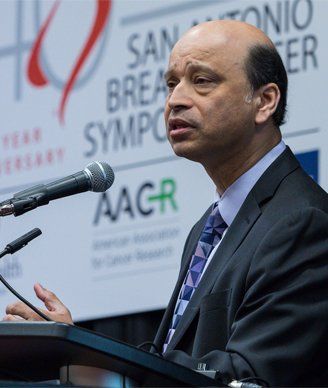Ribociclib Offers Substantial PFS Improvement in Advanced, Premenopausal Breast Cancer
The addition of the CDK4/6 inhibitor ribociclib to endocrine therapy with either tamoxifen or an aromatase inhibitor significantly improved progression-free survival among premenopausal and perimenopausal women with breast cancer.
Debu Tripathy, MD, presenting the results. Photo by © MedMeetingImages/Todd Buchanan 2017

The addition of the CDK4/6 inhibitor ribociclib to endocrine therapy with either tamoxifen or an aromatase inhibitor significantly improved progression-free survival (PFS) among premenopausal and perimenopausal women with breast cancer, according to a new study presented at the 2017 San Antonio Breast Cancer Symposium (SABCS), held December 5–9.
“There is a clear unmet need in premenopausal patients with hormone receptor–positive, HER2-negative advanced breast cancer,” said lead study author Debu Tripathy, MD, of the University of Texas MD Anderson Cancer Center in Houston, during a press conference. Younger women with breast cancer have distinct tumor biology and experience more aggressive disease; endocrine therapy along with ovarian suppression is recommended, but resistance and disease progression ultimately occur in nearly all patients.
Ribociclib has been shown to prolong PFS in postmenopausal women and is approved in that setting. The new MONALEESA-7 trial is the first phase III study evaluating CDK4/6 inhibition as a frontline therapy for premenopausal women. It included 672 patients randomized to either ribociclib (335 patients, 87 in combination with tamoxifen and 248 in combination with an aromatase inhibitor) or to placebo (337 patients, 90 in combination with tamoxifen and 247 with an aromatase inhibitor).
Ribociclib patients had a median age of 43 years, while placebo patients had a median age of 45 years. Most patients were white, and more than half in each group had only visceral metastases.
PFS was highly significantly better with ribociclib than with placebo. The median PFS was 23.8 months with the CDK4/6 inhibitor, and 13 months with placebo, for a hazard ratio (HR) of 0.553 (95% CI, 0.441–0.694; P = .0000000983). A blinded independent review committee confirmed these results.
The benefits were similar across a variety of subgroups, and notably, did not differ substantially based on which endocrine therapy partner was used. Among those treated with tamoxifen, the HR in favor of ribociclib was 0.585 (95% CI, 0.387–0.884); in the aromatase inhibitor–treated patients, the HR was 0.569 (95% CI, 0.436–0.743).
The overall response rate among all patients was 40.9% with ribociclib and 29.7% with placebo (P = .00098). Overall survival data was not yet mature.
Dose interruptions and reductions were required in 76.6% and 35.1% of ribociclib patients, respectively, and in 37.6% and 6.3%, respectively, of placebo patients; most of these were due to adverse events (AEs). Grade 3 neutropenia occurred in 50.7% of ribociclib patients, and grade 4 occurred in 9.9%; in the placebo group, these rates were 3% and 0.6%, respectively. Non-hematologic grade 3/4 AEs were rare in both groups. Patient-reported outcomes based on the EORTC QLQ-C30 were significantly better with ribociclib than with placebo, and a clinically meaningful delay in time to definitive deterioration was seen with the study drug.
Tripathy said these results suggest ribociclib is a potential new treatment option in premenopausal women. Virginia G. Kaklamani, MD, of UT Health San Antonio and a co-director of SABCS 2017, emphasized the importance of these data because they are the first on this class of agent specifically in this setting. “We struggled in the past,” she said, as it was not clear if the agents worked similarly in young women as they did in older patients.